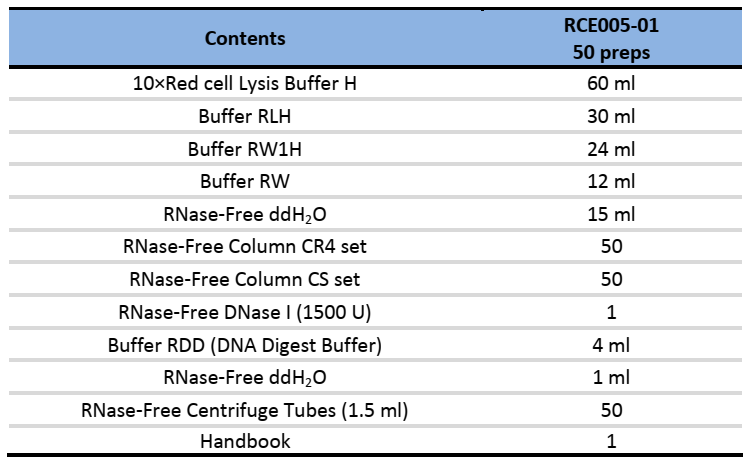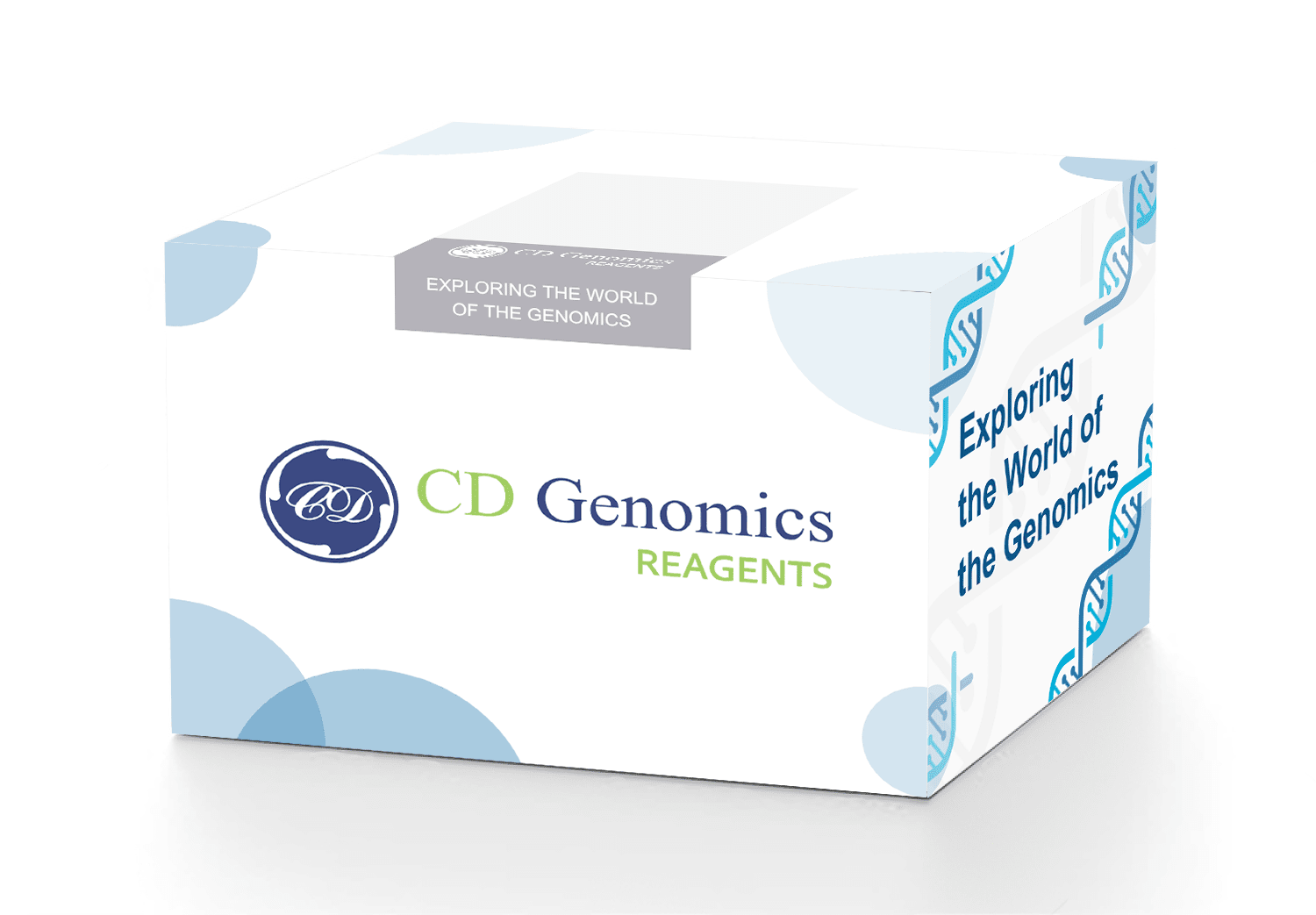Blood Total RNA Kit is specifically designed for total RNA isolation from various species of fresh blood specimens and whole blood with various anticoagulants in a fast, easy, and cheap manner. This kit has a maximum capacity of 1107 white blood cells that it can treat. Proteins and genomic DNA contamination in blood samples are removed using proprietary silica-membrane technology, a special buffer solution, and a proprietary DNase I. Total RNA that has been purified can be used directly in molecular biological experiments like RT-PCR, Real-time RT-PCR, Northern Blot, and RNA library construction, etc. Because whole blood samples have the potential to be infectious, precautions should be taken. DNaseI, Buffer RDD, and RNase-Free ddH2O (tubular) should all be kept at 2-8°C. The buffer RLH/-mercaptoethanol mixture can be stored for one month at 4°C. Other reagents can be kept at room temperature (15-25°C) for a long time.
Storage:
DNaseⅠ, Buffer RDD and RNase-Free ddH2O (tubular) should be stored at 2-8℃. Buffer RLH/β-mercaptoethanol mix can be stored at 4°C for 1 month. Other reagents can be stored at room temperature (15-25℃).
Components:

Specifications:
| Features | Optimized buffers for fresh blood samples enables a fast, convenient and stable workflow for total RNA isolation. No phenol-chloroform extraction enables the workflow more safety. Unique filtration column CS eliminates other contaminations. |
| Application | The purified total RNA can be used directly for molecular biological experiments such as RT-PCR, Real-time RT-PCR, Northern Blot, and RNA library construction, etc. |
| Sample type | Suits to different species of fresh blood samples and whole blood with different anticoagulants, not suitable for frozen blood samples. |
- Lysis Buffer dilution. 10×Red cell Lysis Buffer H is supplied as concentrate. According to the volume of the sample, prepare appropriate volume of fresh 1×Red cell Lysis Buffer H of 10×Red cell Lysis Buffer H, by diluting it in RNase-Free ddH2O according to a ratio of 1:9 (for example, if there is 200μl whole blood sample should be processed, it is recommended to dilute 140μl 10×Red cell Lysis Buffer H).
- Mix 1 volume of human whole blood with 5 volume of 1×Red cell Lysis Buffer H in an appropriately sized tube.
- Use an appropriate amount of whole blood. Up to 1.5 ml of healthy blood (typically 4000–7000 leukocytes per microliter) can be processed. Reduce amount appropriately if blood with elevated numbers of leukocytes is used. (In this case, also adjust amount of 1×Red cell Lysis Buffer H in step 5.)
- Incubate for 10-15 min on ice. Mix by vortexing briefly 2 times during incubation. The cloudy suspension becomes translucent during incubation, indicating lysis of erythrocytes. If necessary, incubation time can be extended to 20 min.
- Centrifuge at 2,100rpm(~400 x g) for 10 min at 4°C, and completely remove and discard supernatant.
- Add 1×Red cell Lysis Buffer H to the cell pellet (use 2 volumes of 1×Red cell Lysis Buffer H per volume of whole blood used in step 2. For example, add 2 ml of 1×Red cell Lysis Buffer H per 1 ml of whole blood used in step 2.). Resuspend cells by vortexing briefly.
- Centrifuge at 2,100rpm(~400 x g) for 10 min at 4°C, and completely remove and discard supernatant.
- Add Buffer RLH (Ensure that β-ME has been added to Buffer RLH before use) to pelleted leukocytes according to the table below. Vortex or pipet to mix.
- Pipet lysate directly into a Column CS set in a 2 ml collection tube and centrifuge for 2 min at Column CS set to homogenize. Discard Column CS set and save homogenized lysate.
- Add 1 volume (350 µl or 600 µl) of 70% ethanol to the homogenized lysate and mix by pipetting. Do not centrifuge. Carefully pipet sample, including any precipitate which may have formed, into a new column CR4 set in a 2 ml collection tube without moistening the rim. Centrifuge for 30-60s at 12,000 rpm (~13,400 × g). Maximum loading volume is 700 µl. If the volume of the sample exceeds 700 µl, successively load aliquots onto the column CR4 set and centrifuge as above. Discard flow-through, and put the column CR4 set back to the collection tube.
- If not performing DNase digestion, apply 700 µl Buffer RW1H to the column CR4 set and centrifuge for 30-60s at 12,000 rpm (~13,400 × g) to wash. Discard flow-through, put the column CR4 set back to the collection tube and go straight to step 14.
- DNase I working solution preparation: add 10 µl DNase I stock solution to 70 µl Buffer RDD in a new RNase-Free Centrifuge Tubes. Mix by gently inverting the tube.
- Add the DNase I working solution (80 μl) directly to the column CR4 set membrane, and place on the bench top (15-25°C) for 15 min.
- Add 350 µl Buffer RW1H to the column CR4 set. Close the lid gently, and centrifuge for 30-60s at 12,000 rpm (~13,400 × g). Discard the flow-through, put the column CR4 set back to the collection tube.
- Pipet 500 µl of Buffer RW (Ensure that ethanol has been to added Buffer RW before use) into the column CR4 set, stand for 2 min at room temperature (15-25°C), centrifuge for 30-60s at 12,000 rpm (~13,400 × g). Discard flow-through, and put the column CR4 set back to the collection tube.
- Repeat step 14.
- Centrifuge for 2min at 12,000 rpm (~13,400 × g) to dry the column CR4 set membrane.
- Transfer column CR4 set into a new 1.5 ml RNase-Free Centrifuge Tubes and pipet 30–50 µl of RNase-free ddH2O directly onto the column CR4 set membrane. Close the lid gently, place at room temperature (15-25°C) for 2 min, centrifuge for 2 min at 12,000 rpm (~13,400 × g) to elute. Repeat if >0.5 ml whole blood (or >2 x 106 leukocytes) has been processed.
| Buffer RLH (μl) | Healthy whole blood (ml) | No. of leukocytes |
|---|---|---|
| 350 | Up to 0.5 | Up to 2×106 |
| 600 | 0.5 to 1.5 | 2×106 to 1×107 |
DNase I digestion: Add 350 µl Buffer RW1H to the column CR4 set, centrifuge for 30-60s at 12,000 rpm (~13,400 × g) to wash the column membrane. Discard the flow-through, put the column CR4 set back to the collection tube.


